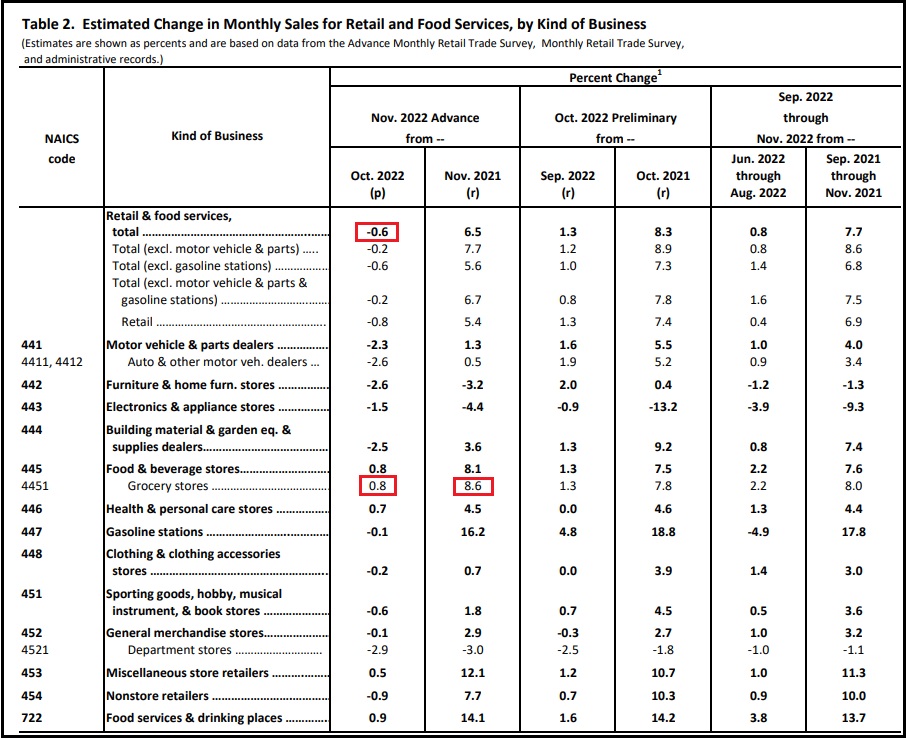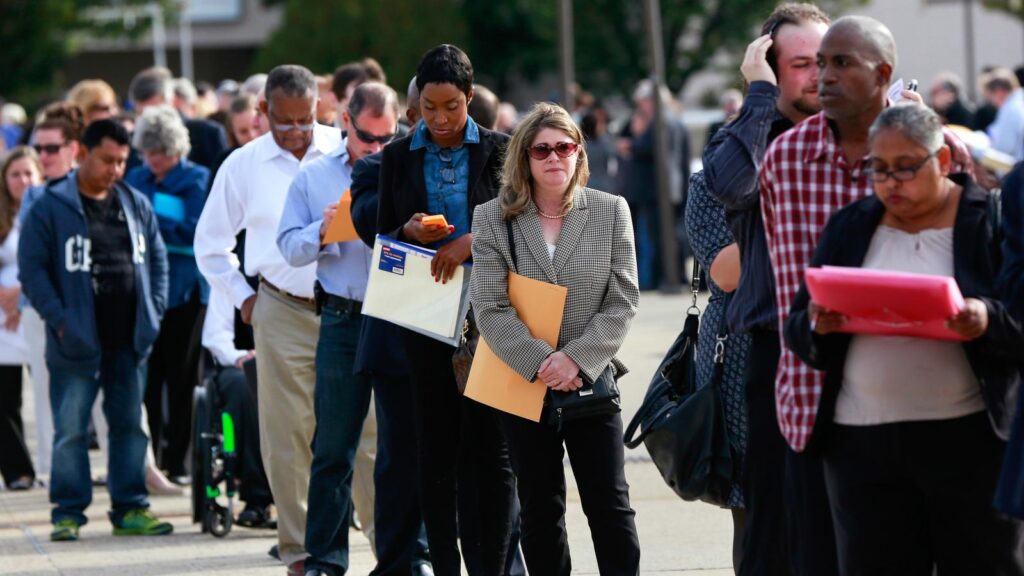Friends, in the late summer and fall of 2021 CTH warned of massive waves of price increases that would push inflation to record highs. We watched as each wave arrived almost on schedule throughout 2022, and as a direct result of Joe Biden energy and economic policy, prices necessarily skyrocketed.
In essence in 2021 we were warning about the expenditure side of the ledger that all working-class and fixed income families would experience. We advised to take every proactive measure possible to avoid future price increases.
Now, unfortunately, we begin moving those same warnings to the other side of the ledger; because as a natural consequence of consumer checkbook pain, the financial pressure always transfers to the income and employment side of the economic dynamic.
Keep in mind, retail sales are calculated in dollars spent by consumers. November 2022 retail sales as reported by the commerce department today [DATA pdf], reflect a 0.6% decrease in spending vs October. November data includes Thanksgiving, Black Friday and the traditional early holiday shopping. 0.6% less dollars were spent, despite prices being double digits higher than the prior year.
When the prices you are charging for goods and/or services are 10, 20, even as high as 60 percent more than prior year, yet your sales are running flat to negative – that means consumer purchases of those goods/services are substantially lower.
If you were selling 100 widgets for $1 each in 2021, you gross $100. If your widgets now sell for $1.25 and you gross $94 in 2022 sales, you have sold 75 widgets.
In 2021 you sold 100 widgets, in 2022 you sold 75 widgets, a difference of 25 widgets.
Everything attached to the raw material, creation, manufacturing, distribution and sale of those 25 missing widgets is no longer part of the economic activity associated with your widget business. You are now telling your suppliers you don’t need as many widgets, because they are not selling. You have lost 25% of your business in this scenario.
Everything associated with the drop in consumer spending now begins to downsize. Downsizing means less labor needed. This process triggers the economic impact shifting from the consumer sales side of the ledger to the income side of the ledger for employers, employees and workers.
If this consumer spending trend continues, and there is absolutely no reason to think it will reverse, we are entering a phase of serious financial instability for the American worker, at a scale that will dwarf the 2006/’07 and ’08 recession.
I am not a doomsayer pundit on economic matters. I am a proactive planner on economic forecasts. With consumer credit costing more, with fed interest rates climbing, with import orders cancelled, with shipping costs dropping, with consumer spending contracting, with fewer units moving, with inventories climbing, all of the data only points in one direction.
Serious consumer defaults are looming.
Government policy has been hammering the demand side of the economy, proclaiming -falsely- that excessive consumer demand was the cause of inflation. This game of economic pretending is about to get very serious.
Consumer spending, as measured in actual units created and purchased in the economy, has been contracting since the third quarter of 2021 (started June, July, August ’21). Simultaneously, consumer spending as measured in actual dollars spent to purchase food, fuel and energy, has been skyrocketing. This is a supply side inflationary cycle with no soft landing.
(Wall Street Journal) – U.S. retail spending and manufacturing weakened in November, signs of a slowing economy as the Federal Reserve continues its battle against high inflation.
November retail sales fell 0.6% from the prior month for the biggest decline this year, the Commerce Department said Thursday. Budget-conscious shoppers pulled back sharply on holiday-related purchases, home projects and autos. Manufacturing output declined 0.6%, the first drop since June, the Fed said in a separate report.
The Fed on Wednesday raised its benchmark interest rate 0.5 percentage point to a 15-year high and signaled plans to continue lifting rates through the spring. Fed officials have increased rates at the fastest pace since the 1980s to cool the economy and bring down inflation, which is running near a 40-year high.
“Most households are acting strategically, planning for a road ahead that may be more difficult to traverse, with higher interest rates, the housing slump, and ongoing inflation—and the very real possibility of a recession,” said Craig Johnson, president of the retail consulting firm Customer Growth Partners. (read more)
Businesses are going to start cutting expenses in order to survive.
The number one expense for almost all businesses is the labor cost.
Non-essential and high wage labor is going to get removed first.



Sundance you are awesome at explaining the economics in a way that most can follow.
I am a high level finance leader at major consumer products company. Been trying to get employees to understand the inflation that was coming, pricing action we needed, cost contracts and the negative impact on production utilization. Your 100 to 75 widget should be easy for most to understand
Unfortunately, it is too late for the storm that is coming to my company (and many others i have talked to). They still think things are not too bad because 2022 results have been based on input costs that were locked in early Q1.
I think they might understand when our suppliers increase raw materials by 15-25%, that 6% finished goods price increase are not gonna cover all the variable and fix cost pressure of the JoeBama regime
Treepers, get ready for even higher price tags on everything in 2023 as all the major producers won’t be able to keep squeezing suppliers
Looks like you see leading indicators which are more than 2 quarters.
It is fun watching inflation when they slow down shipments knowing they can get a higher price later.
henry Chance: The problem is not a matter of suppliers holding back product to take price increases. The problem is lack of product availability, due to messed up supply chains.
In some industries, there is product stranded at higher than current costing because of the shipping costs inflated last year.
People who costed product at $500/widget and added $500 shipping/widget last year need to mark it to to $2000 to make a profit.
But they are competing against new goods coming in this year at $550/widget + $150 shipping/widget who only need to mark to $1400/widget.
There are going to be alot of writedowns and bankruptsies from that.
bkrg2: The input costs at our business (private health practice) have been rising steadily for more than a year and our major corporate suppliers have been ahead of the pack to raise prices, increase delivery costs and boost fuel surchages (in the case of supplier who deliver heavy products by deisel-fueled trucks (for example, our supplier of medical gases, which are supplied in steel cylinders).
Yep CPI is down stream of PPI. Logic 101.
Against all the truth in this article is the reversal of globalism from the US weaponizing the dollar. Absorbing European manufacturing is a countervailing trend. Reengineering China-centric supply chains is countervailing.
The only reversal in globalism is coming from the gray areas on the graph, BRICS. The West is committing suicide and the rest of the world will most likely not follow in our path. The elephant in the room is all the dollars held overseas as we were the international trading currency. When the BRICS come up with their gold backed trading currency and Saudi Arabia uses it for oil trading, the dollar is going to Inflate even more. Do you want to hold worthless dollars or gold backed currency? We import much more than we export, and the inflation that will be loosed on us from the flight from the petrodollar will make today’s problems look like molehills.
Biden shouldn’t have shut down fossil fuel until his windmills and solar panels were in place.
Now, as mid-terms and Arizona demonstrated, we can’t even vote Democrats out of office.
That would make sense if the transition to clean energy was the actual goal.
What we see now is a feature not a flaw.
Wind and solar will not scale, ever, to meet the power needs of our current economy.
The agenda is aimed squarely at crippling the US economy, depopulation, and moving the remaining population into high denisty urban corridors on mass tranist. Agenda 2030/2050.
Ha,ha,ha sorry dude, your wind and solar will never keep up with fossil fuels.
So, not until maybe 2140?
I’m for it! LOL
I rarely comment anymore but Sundance,you are so right.
Every week,I get local notifications of family businesses on Long Island closing after many years,with little explanation.
Each one feels like a loss and lately it feels so darn heavy.
These family businesses will not come again.
Sundance,you and your wonderful wife have been such a gift.
Whatever we are facing,thank you both for sending out the truth.
Even when it’s been hard to hear.
I hope all the wonderful Treepers find safe haven in the next years.
God bless!
1000+ likes. <3 (this is supposed to be a heart).
Lovely words for Sundance..
A pleasure to read and God bless you
I have no inside knowledge or understanding of the fed policies that put chyna on the map for production of cheap stuff that Americans clamored for in the big box stores. Although I believe class warfare in part is responsible…elevated more people to the level of ‘consumer’…be they immigrants, minorities or whoever…One thing is certain, big box retailers benefited. And manufacturers…oh yeah and big pharma…
Inventories are climbing and Sundance predicted that. But going deeper, too, I want to know if there are time limits or ‘sunset clauses’ on any wheeling and dealing policies that are in effect…and a lot of these policies go way back, way way back…Clinton, Bush Bush Obama, (until Trump…)…building upon other extraneous policies.
I don’t wonder if sunset clauses or expiring deals, are not responsible for all the BS out there…
Changing major economic structures, takes decades…health care is a prime example…as one insider explained it to me.
And I still maintain my original hypothesis–big corporations do not want to pay wages. The current economy of the DOW exchange is like a hidden “script system”…
Just and angry old ginger here, wanting her reparations for the abuse endured…
Earlier this year I remembered a headline that said 80% of all dollars that ever existed were printed in the last 2 years. Nearly a year later and I wonder where that figure is now?
Whatever the number, I betcha they’re being sent to Ukraine!
I don’t know why they keep lying about the future recession looming on the horizon. It AIN’T looming, it’s here!!! And it has been here for several quarters.
People austerity can be good for people if self imposed. But not so good if government imposed and we know that is exactly what is going on, time to prepare people this will effect everyone, even if you feel safe with your personnel finances.
Time to see ourselves as more than consumers. That saying ‘worthless eater’, that is the derogatory term for consumer. Time to be producers, working to be self sufficient is being productive. Find others that are trying to be self sufficient Gardening raising chickens (in the Back yard) learn to hunt/fishing farm sharing sewing tanning hides, it is endless how to become a producer.
Get to the point where you could careless what the Fed does or what the CPI is, there millions right now thing about this!
Add this into the mix. This is a true story. It’s likely one that will be repeated.
A locally owned factory employed a woman for 15 years with severe intellectual and behavioral health challenges. Her only skill was she could sand cabinets like nobody’s business! The owners kept her working when others wouldn’t.
The owners sold their business to keep from going bankrupt. The new owners immediately fired the woman.
Where before she was supported and was a contributing member of the community, she now is having to apply for disability.
I’m not saying the new owners were necessarily wrong. I’m saying there is more at stake in losing locally owned small businesses than we can begin to imagine!
Every manufacturing company I worked for had a person like this. Just one. Usually in janitorial. Other employees would help cover for their shortcomings. Management would get creative in hard times to keep them employed. In all cases, they were able to retire or leave on their own terms. But those days are long gone, I’m afraid.
Greed!! No more compassion on USA.
Don’t worry, the chamber of commerce will solve this crises along with a bunch of useless Republicans.
And millions and millions of illiterate 3rd worlders straining our social safety nets as tax revenues will be falling.
Stolen elections do indeed have catastrophic consequences
Nice to see the Washington Post is cutting their labor costs as few people are buying their product.
“Philadelphia Fed Admits US Jobs “Overstated” By At Least 1.1 Million”
I have a question for treepers. PVC pipe price has always gone up whenever petroleum price has increased. PVC has increased in price by ten times since 2020. 1000 percent. It used to be made in Texas by Cantex, at least that was the company I bought from. In 2006 I split a tractor trailer load with my supplier and I paid $0.15 for 3/4″ PVC pipe and $0.45 for 2″ PVC pipe. Has the manufacturing of PVC gone overseas too? Why hasn’t it come down?
Late July-August is the new Christmas.
Back to school expenses are necessary.
Christmas is not.
Back in winter 2020/2021 the price of a dozen eggs at my local ALDI in central FL was $.88.
Those same eggs today (just left ALDI) are $3.78/dozen.
That’s a 330% price increase in less than two years!!!
Thank God I learned some great tips from fellow treepers as far as stocking up on nonperishables, gadening, and buying from local farmers and artisans.
I hope and pray everyone “prepared accordingly” because the s%$t is really going to hit the fan in 2023!
And those of you living off monthly pensions—-BEWARE!
The petro dollar is on it’s way to extinction and the FANGMAN corporations (Facebook, Apple, Netflix, Google, Microsoft, Amazon and NVIDIA) that got enormously bloated by the Fed’s rampant money-printing during the last decade are LOSING trillions!!!
“Alas, the worm has turned. The market cap of the FANGMAN has already dropped by a staggering $4.5 trillion to just $7.1 trillion at present. At the same time, collective earnings of these allegedly perpetual “growth” stocks have declined by nearly 14% since their summer/fall 2021 peak of $336 billion.”
“https://brownstone.org/articles/twitter-became-the-ministry-of-truth/
I say all the BUFFOONS who “voted” (I mean cast FRAUDULENT ballots!!) for DEMENTIA guy should pay the price increases on groceries and utilities.
I was just fine with “mean tweets” and eggs for $.88/dozen, lol!
I wonder what percentage of the drop in sales is due to fewer people buying as in all who “died suddenly” among the working age group and those who are fighting cancers and other disabilities as a result of participating in the Great Global Experimental Gene Therapy Jab? Edward Dowd points out that the 18-40 yo experienced a “Vietnam War Casualty event” as a result of vax mandates. Let the Nuremberg trials begin.
How much of the demand fall-off is explained by the three-sigma rise in Millennial mortality from 2021 into this year, most likely as a result of Op Warp-speed?
All things being equal and like SD, I vastly favor Trump over DeSantis. But that’s just the thing: no recanting from Trump of the C19 vaccines makes all things far from being equal.
If Trump got duped (conceivable), his personality makes recanting well-nigh impossible. Talk about a Deep State checkmate. Understandably, DeSantis’ paper tiger proposal for a Florida investigation plays against this key Trump vulnerability.
And the Philadelphia Fed just announced that the Biden handlers overstated job growth for 2022 by 1.1 million workers. If you are going to lie, go big or go home.
Which is why all the bru-ha-ha over an increase in Black-Friday sales was a chimera. More dollars were spent on lest merchandise.
But, hey, Brandon and his ilk just trounced the RINO GOP and remains in control of the Senate.